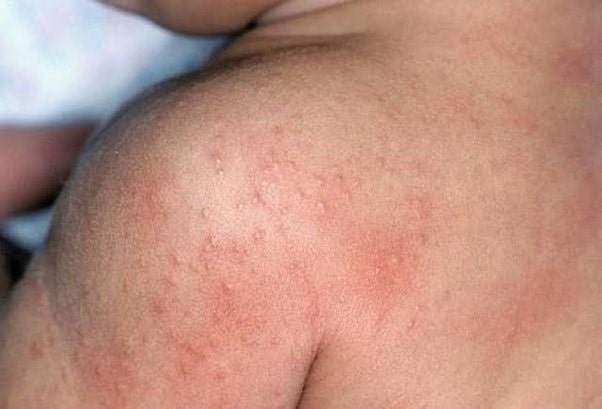What is Prickly Heat?
Prickly heat, also known as miliaria, is a small, reddish rash that causes itching and burning of the skin.
This health problem, also known as heat rash, is more likely to occur in babies, but it does not rule out the possibility of it occurring in adults as well.
This condition is more likely to attack babies because body temperature control in babies is still not perfect.
In addition, the baby’s sweat glands are still developing, so they cannot yet produce sweat optimally.
The location where prickly heat appears in babies is in the neck, groin, and face areas.
Symptoms of Prickly Heat
Actually, prickly heat is a health problem that is not contagious and is not dangerous.
This skin disorder usually occurs more often when you are outdoors in hot or humid conditions.
Symptoms of this condition include:
- The appearance of small reddish spots, especially on parts of the body that often sweat.
- Stinging and itching sensation in the rash.
These symptoms can appear on all parts of the body and attack regardless of age.
However, babies and children are more susceptible to it.
Some conditions also show that prickly heat can look similar to sand acne.
Causes of Prickly Heat
Blocked sweat glands are the main cause of this condition, triggering the appearance of a rash followed by inflammation.
However, it is not known what exactly causes the blockage of the sweat glands.
Some factors that are believed to increase the risk of this condition are:
- Tropical climate. Hot, humid, and humid climates are the main triggers.
- Overheating. Sweat glands can also become blocked due to overheating. This includes wearing clothing that is too thick or too tight.
- Doing certain physical activities. Exercise makes the body sweat a lot, which can also trigger this condition.
- Underdeveloped sweat glands. This is the main cause that attacks babies. This condition makes sweat more easily trapped in the inner part of the skin.
- Overweight. Obesity also increases the risk of prickly heat, especially in body folds such as the groin, neck, and stomach.
- Lying down for too long. This is more likely to happen to people with certain diseases who have to lie down for a long time, especially with a fever.
Types of Prickly Heat
Based on the severity of skin damage, prickly heat is divided into several types, including:
Miliaria Crystalline
This type is the mildest and affects only the upper skin.
Miliaria crystallina is characterized by the appearance of red spots that contain clear fluid and break easily.
Usually, this condition is not accompanied by pain and itching.
Miliaria Rubra
Next, there is miliaria rubra which attacks deeper layers of the skin.
This type is more likely to occur in adults than in children.
Symptoms include the appearance of red spots with itching and burning sensation.
Miliaria Pustulosa
If miliaria rubra is not treated immediately and becomes inflamed, it can develop into miliaria pustulosa.
Symptoms of this type include the appearance of red spots containing pus which causes the color to change to yellow or white.
The pus indicates that a skin infection is starting to occur.
Miliaria deep
Meanwhile, miliaria deep is a type that can be said to be very rare.
This condition occurs in deeper parts of the skin.
Sweat that is trapped and cannot escape will result in the appearance of red spots that are larger in size and have a harder texture.
Although less common, miliaria deep is chronic and can recur.
Prickly Heat Diagnosis
In order to get a more accurate diagnosis, the doctor will definitely conduct an interview regarding the symptoms or complaints experienced, the medical history or health condition, and the condition of the environment where the sufferer lives.
After that, the doctor will perform a physical examination on the sufferer by directly observing the rash that appears.
However, no supporting examinations are required for the diagnosis of prickly heat.
Prickly Heat Treatment
Prickly heat is not a dangerous health problem so it can be treated independently with several simple methods, such as:
- Apply a moist or cold compress for about 20 minutes once every hour to the area of the body affected by the rash.
- Maintain cleanliness of the area of the body that has a rash by using mild soap and running water.
- Using talcum powder on areas affected by prickly heat can help reduce skin discomfort.
- Keep your skin cool by taking a shower or bath.
- It is best to avoid humid places and hot weather. Use air conditioning or a fan to cool the room.
- Fulfill your body’s fluid intake to prevent dehydration.
- Wear loose clothing so that sweat does not get blocked.
Meanwhile, if the prickly heat that appears is more severe and disturbs the sufferer’s comfort, doctors usually provide treatment by:
- Giving antihistamines to help relieve redness and itching on the skin surface.
- Using corticosteroid ointments to help relieve inflammation and itching.
- Apply calamine lotion to help relieve pain, itching, or irritation.
- Use antibiotics if a secondary infection occurs along with prickly heat.
- Giving medication to help prevent blockage of sweat glands and stop new rashes from appearing.
Prevention of Prickly Heat
The best way to prevent prickly heat is of course to avoid various risk factors that can trigger blockages in the sweat glands.
The method is as follows:
- Always keep your skin cool and cool.
- Use soap products with gentle ingredients and do not contain perfume.
- Don’t wear clothes that are too thick and tight.
- Try to wipe off sweat after activities or exercise.

